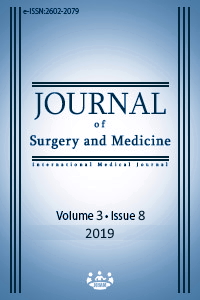Use of video-laryngoscopy in pediatric patients with Ehlers-Danlos syndrome: Two case reports
Keywords:
Ehlers-Danlos, Anesthesia, Difficult airway, Video-laryngoscopyAbstract
Difficult airway management is one of the most challenging situations for an anesthesiologist. If not handled properly, it can lead to severe complications, even death. Video-laryngoscopy (VL) is one of the many techniques developed for this purpose. Ehlers-Danlos Syndrome (EDS) is a rare disease requiring possible difficult airway management due to temporo-mandibular dysfunction or occipito-atlanto-axial instability. We herein present two pediatric EDS cases who required surgery. The first case was a 9-year-old, male, ASA II EDS patient scheduled for strabismus surgery, and the second case was a 12-year-old, male, ASA III EDS patient who was also diagnosed with a brain cyst and lymphoma, due for emergency surgery for acute abdomen. With their heads in a neutral position, both patients were intubated without tissue trauma at first attempt using video-laryngoscopy. No complications were encountered in both cases. We believe that using video-laryngoscopy for managing difficult pediatric airways may be beneficial in avoiding complications.
Downloads
References
Callewaert B, Malfait F, Loeys B, De Paepe A. Ehlers-danlos syndromes and Marfan syndrome. Best Pract Res Clin Rheumatol. 2008;22:165–89.
Halko GJ, Cobb R, Abeles M. Patients with type IV ehlers-danlos syndrome may be predisposed to atlantoaxial subluxation. J Rheumatol. 1995;22:2152–5.
Johnston BA, Occhipinti KE, Baluch A, Kaye AD. Ehlers-Danlos Syndrome: Complications And Solutıons Concerning Anesthetic Management. Middle East Journal Anaesthesiology. 2006;18(6):1171-84.
Wiesmann T, Castori M, Malfait F, and Wulf H. Recommendations for anesthesia and perioperative management in patients with Ehlers-Danlos syndrome(s) Orphanet J Rare Dis. 2014;9:109.
Uitto J, Ringpfell F. Ehlers-Danlos Syndrome-Molecular Genetics, Beyond the Collagens. The Society for Investigative Dermatology. 2004;122:4.
Beighton P, De Paepe A, Steinmann B, Tsipouras P, Wenstrup RJ. Ehlers-Danlos syndromes: revised nosology. Am J Med Genet. 1998;77:31-7.
Campbell N, Rosaeg OP. Anesthetic management of a parturient with Ehlers Danlos syndrome type IV. Can J Anaesth. 2002;49(5):493-6.
De Paepe A, Malfait F. Bleeding and bruising in patients with Ehlers-Danlos syndrome and other collagen vascular disorders. British Journal of Haematology. 2004;127:491-500.
Germain DP. Ehlers-Danlos syndrome type IV. Orphanet Journal of Rare Diseases. 2007;2:1-9
Sood V, Robinson DA, Suri I. Difficult intubation during rapid sequence induction in a parturient with Ehlers-Danlos syndrome, hypermobility type. Int J Obstet Anesth. 2009;18:408-12.
Yen J, Lin SP, Chen MR, Niu DM. Clinical features of Ehlers Danlos syndrome. J Formos Med Assos. 2006;105:475-80.
Ohshita N. Kanazumi M, Tsuji K, Yoshida H, Morita S, Momota Y, et al. Anesthetic Management of a Patient With Ehlers-Danlos Syndrome. Anesth Prog. 201;63(4):204-7.
Jiang J, MA Dx, Li B, Wu As, Xue Fs. Videolryngoscopy versus direct laryngoscopy for nasotracheal intubation: A systematic review of randomised control trials. Journal of Clinical Anesthesia. 2019;52(12):6-16
Watt S, Kalpan J, Kolli V. Case report of the use of videolaryngoscopy in thyroid goiter masses:An airway challenge. Int J Surg Case Rep. 2016;27:119-21. doi: 10.1016/j.ijscr.2016.06.018.
Madziala M, Smereka J, Dabrowski M, Leung S, Ruetzler K, Szarpak L. A comparison of McGrath MAC and standard direct laryngoscopy in simulated immobilized cervical spine pediatric intubation: a manikin study. Eur J Pediatr. 2017;176(6):779-86.
Downloads
- 1210 1870
Published
Issue
Section
How to Cite
License
Copyright (c) 2019 Mehmet Kenan Erol, Firdevs Kaya
This work is licensed under a Creative Commons Attribution-NonCommercial-NoDerivatives 4.0 International License.
















